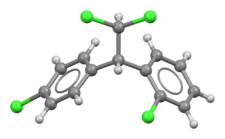Mitotane
 | |
 | |
| Clinical data | |
|---|---|
| Trade names | Lysodren |
| Other names | 1,1-(Dichlorodiphenyl)-2,2-dichloroethane; o,p'-DDD |
| AHFS/Drugs.com | Monograph |
| MedlinePlus | a608050 |
| License data | |
| Routes of administration | By mouth |
| ATC code | |
| Legal status | |
| Legal status | |
| Pharmacokinetic data | |
| Bioavailability | 40% |
| Protein binding | 6% |
| Elimination half-life | 18–159 days |
| Identifiers | |
| |
JSmol) | |
| Chirality | Racemic mixture |
| Melting point | 76 to 78 °C (169 to 172 °F) |
| |
| |
| (verify) | |
Mitotane, sold under the brand name Lysodren, is a
Medical uses
Mitotane has been produced by Bristol Myers Squibb but it is marketed as an orphan drug for adrenocortical carcinoma due to the small number of patients in need of it. Its main use is in those patients who have persistent disease despite surgical resection, those who are not surgical candidates, or those who have metastatic disease. In a 2007 retrospective study of 177 patients from 1985 to 2005 showed a significant increase in the recurrence-free interval after radical surgery followed by mitotane when compared to surgery alone.[8] The drug is also sometimes used in the treatment of Cushing's syndrome.[5]
Side effects
The use of mitotane is unfortunately limited by side effects,[9] which, as reported by Schteinberg et al., include anorexia and nausea (88%), diarrhea (38%), vomiting (23%), decreased memory and ability to concentrate (50%), rash (23%), gynecomastia (50%), arthralgia (19%), and leukopenia (7%).[10]
Pharmacology
Pharmacodynamics
Mitotane is an inhibitor of the
Chemistry
Analogues of mitotane include aminoglutethimide, amphenone B, and metyrapone.
History
Mitotane was introduced in 1960 for the treatment of adrenocortical carcinoma.[5]
Society and culture
Generic names
Mitotane is the
Brand names
Mitotane is sold under the brand name Lysodren.[6]
Veterinary use
Mitotane is also used to treat
References
- FDA. Retrieved 22 Oct 2023.
- ^ "Product monograph brand safety updates". Health Canada. 7 July 2016. Retrieved 3 April 2024.
- ^ ISBN 978-1-4557-1126-0.
- PMID 15898346.
- ^ ISBN 978-1-60327-449-4.
- ^ ISBN 978-1-4757-2085-3.
- ^ "Mitotane". PubChem. U.S. National Library of Medicine.
- PMID 17554118.
- ^ ISBN 978-1-84184-951-5.
- PMID 7115060.
- ISBN 978-1-61705-019-0.
- ISBN 978-1-4613-1001-3.
- ISBN 978-3-88763-075-1.
- ^ Nichols R. "Canine Cushing's Syndrome: Diagnosis and Treatment Part 1: Typical, Atypical, and Pseudo-Cushing's Disease" (PDF). Archived from the original (PDF) on 2007-10-21.
Further reading
- Komissarenko VP, Chelnakova IS, Mikosha AS (1978). "Effect of o,p-dichlorodiphenyldichloroethane and perthane in vitro on glutathione reductase activity in the adrenals of dogs and guinea pigs". Bulletin of Experimental Biology and Medicine. 85 (2): 152–154. S2CID 23181221.
External links
- "Mitotane – information sheet". Government of Canada. 2017-10-16.
- "RISK MANAGEMENT SCOPE for Benzene, 1-chloro-2-[2,2-dichloro-1-(4-chlorophenyl)ethyl]- (Mitotane)]" (PDF). Environment Canada & Health Canada. July 2013. Archived from the original (PDF) on 10 August 2014.
